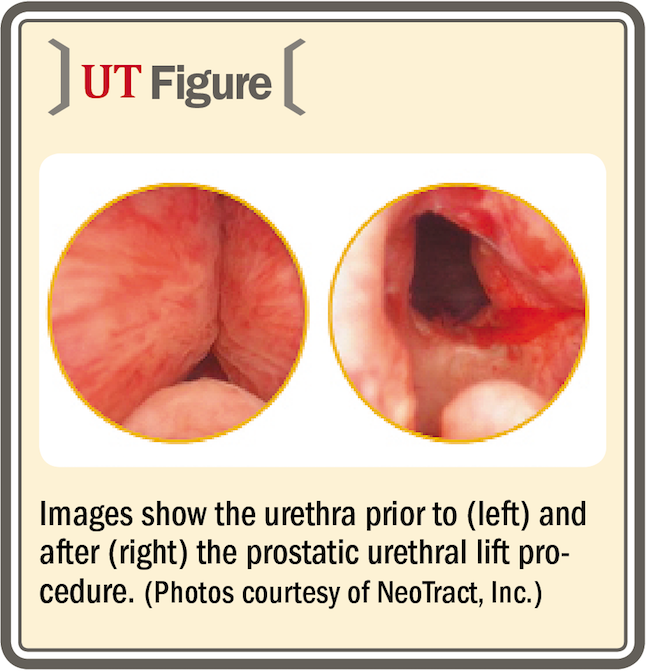Article
Study: BPH procedure’s benefits sustained at 3 years
Author(s):
The prostatic urethral lift (PUL [UroLift, NeoTract, Inc.]) yields successful 3-year durability and superior rate of improvement of BPH symptoms compared to transurethral resection of the prostate, according to separate studies presented at the AUA annual meeting in New Orleans.
New Orleans-The prostatic urethral lift (PUL [UroLift, NeoTract, Inc.]) yields successful 3-year durability and also has a superior rate of improvement of BPH symptoms compared to transurethral resection of the prostate (TURP), according to separate studies presented at the AUA annual meeting in New Orleans.

Dr. Roehrborn“PUL offers a clinically meaningful improvement in lower urinary tract symptoms (LUTS) and urinary flow that can be sustained for 3 years. The procedure is associated with low morbidity and preservation of sexual function,” said Claus G. Roehrborn, MD, professor and chairman of urology at the University of Texas Southwestern Medical Center in Dallas.
The UroLift is a permanent implant sized (in situ) to accommodate the prostate. The goal is to widen the urethral channel by lifting or holding enlarged prostate tissue out of the way.
Related: BPH technique efficacious even in severe obstruction
One international study, known as the L.I.F.T. study, was conducted in 19 centers (14 U.S., three Australian, two Canadian). The authors randomized 206 subjects 2:1 for PUL versus sham. The sham was single-blinded, and the assessor at each investigator site was also blinded to the actual treatment.
Patients were over the age of 50 years with an AUA Symptom Index (AUASI) over 13 and maximum urinary flow rate (Qmax) under 12 mL/s. Patients underwent washout of alpha-blockers, 5-alpha-reductase inhibitors, and anticoagulants.
NEXT: AUASI reduction sustained through 3 years
More on BPH
Bipolar vaporization: Do benefits outweigh risks?
Study supports BPH laser’s use in high-risk men
AUASI reduction sustained through 3 years
For the 140 patients treated with PUL, AUASI reduction was 44% after 1 month and sustained at 43% through 3 years (p<.0001). Adverse events were typically mild and transient, with the most frequent being hematuria, dysuria, pelvic pain, urgency, and urge incontinence. Sexual function, however, was preserved with no incidence of de novo or sustained erectile or ejaculatory adverse events.

“At 3 months, the patients had a significant improvement in their symptom score, urinary flow rate, quality of life, and BPH index, compared to the sham group. All sexual questionnaires showed no changes between the active and the sham group,” said Dr. Roehrborn, lead author of the L.I.F.T. study.
After 3 years, change in symptom score was maintained at 8.9, which represents a 41% improvement and is significant against baseline, he reported. Flow rate also maintained a 53% improvement from baseline over the course of 3 years.
Read: Study uncovers 400% cost difference in BPH treatments
Dr. Roehrborn noted that 2.1% of the implants had to be removed because they were exposed.
“This is clearly an issue of experience and teaching the procedure,” he said. “The technique must be properly learned.”
This study will continue to assess durability out to 5 years.
“The procedure is well tolerated under local anesthesia, provides rapid and significant symptom relief, improves urinary flow rate, and preserves sexual and ejaculatory function in all patients,” Dr. Roehrborn concluded.
Results of the L.I.F.T. study were also published in the Canadian Journal of Urology (2015; 22:7772-82).
NEXT: PUL versus TURP
PUL versus TURP
A separate, randomized controlled study compared the PUL procedure to the current standard of care, TURP.
“TURP is the gold-standard surgery with regard to effectiveness in treating BPH but is associated with significant morbidity,” said lead author Neil Barber, MD, of Frimley Park Hospital NHS Foundation Trust, Surrey, United Kingdom. “When assessed for overall improvement, including LUTS, sexual function, continence, and safety, PUL subjects responded more consistently than TURP. Patient satisfaction rose more quickly for PUL and was sustained to 1 year.”
The authors randomized 80 patients 1-to-1 across 10 centers in three countries in Europe. The primary endpoint of the study was to demonstrate non-inferiority of the PUL versus TURP using a composite endpoint that incorporates symptom relief, recovery experience, sexual health, continence preservation, and lack of high-grade adverse event.
“The vast majority of patients, greater than 77%, returned to normal activity within a month,” said Dr. Barber. “They reported minimal impact upon erectile function, no impact upon ejaculatory function, no impact upon continence, and no levels of complications. It is interesting that the reoperation rate within this first year is higher in the TURP group as well.”
According to Dr. Barber, patients treated with TURP had better outcomes in terms of International Prostate Symptom Score and maximum flow rate, but improvements in quality-of-life score were not statistically different within a year. However, when all of these endpoints are combined, a significantly better outcome is seen in the PUL group, with more than 50% of patients achieving overall improvement compared to 20% in the TURP group.
“We see superior improvement in terms of rapid return to normal activity and rate of improvement in symptoms in the PUL group compared to TURP, as well as improvement in terms of preservation of sexual function,” Dr. Barber concluded. “But, clearly, longer term data will be required to understand that more fully.”
NeoTract provided funding for both studies. Dr. Roehrborn is a consultant/adviser and investigator for NeoTract. Dr. Barber is an investigator for NeoTract. Several co-authors of both studies are consultants/advisers and/or investigators for NeoTract.
More from Urology Times:
Biomarkers offer insight into PCa racial disparity
TRT, blood clot risk evaluated in large analysis
Study: No significant link between diabetes Tx, bladder Ca
Subscribe to Urology Times to get monthly news from the leading news source for urologists.




